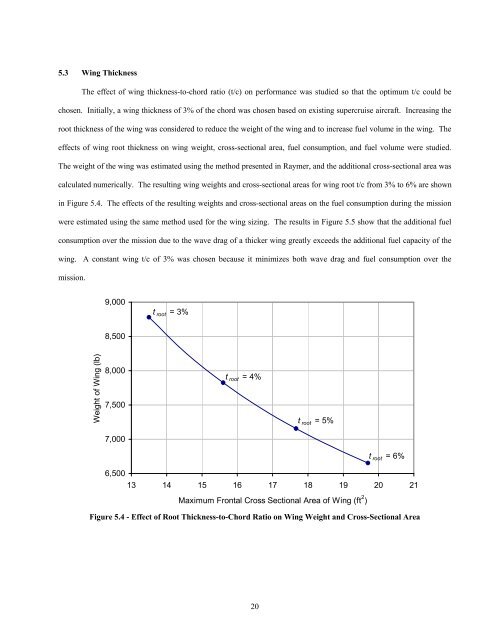Vendetta Final Proposal Part 1 (3.4 MB) - Cal Poly
Vendetta Final Proposal Part 1 (3.4 MB) - Cal Poly
Vendetta Final Proposal Part 1 (3.4 MB) - Cal Poly
- No tags were found...
You also want an ePaper? Increase the reach of your titles
YUMPU automatically turns print PDFs into web optimized ePapers that Google loves.
5.3 Wing ThicknessThe effect of wing thickness-to-chord ratio (t/c) on performance was studied so that the optimum t/c could bechosen. Initially, a wing thickness of 3% of the chord was chosen based on existing supercruise aircraft. Increasing theroot thickness of the wing was considered to reduce the weight of the wing and to increase fuel volume in the wing. Theeffects of wing root thickness on wing weight, cross-sectional area, fuel consumption, and fuel volume were studied.The weight of the wing was estimated using the method presented in Raymer, and the additional cross-sectional area wascalculated numerically. The resulting wing weights and cross-sectional areas for wing root t/c from 3% to 6% are shownin Figure 5.4. The effects of the resulting weights and cross-sectional areas on the fuel consumption during the missionwere estimated using the same method used for the wing sizing. The results in Figure 5.5 show that the additional fuelconsumption over the mission due to the wave drag of a thicker wing greatly exceeds the additional fuel capacity of thewing. A constant wing t/c of 3% was chosen because it minimizes both wave drag and fuel consumption over themission.9,000t root = 3%8,500Weight of Wing (lb)8,0007,500t root = 4%t root = 5%7,000t root = 6%6,50013 14 15 16 17 18 19 20 21Maximum Frontal Cross Sectional Area of Wing (ft 2 )Figure 5.4 - Effect of Root Thickness-to-Chord Ratio on Wing Weight and Cross-Sectional Area20













